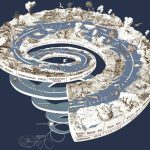REGION
MontpellierOBSERVATION
CetaceansPERIOD
2002AUTHOR(S)
Julien MARCHALStéphanie RAYNAUD

Hello to all,
Our report on : Pollution and its effects on cetaceans
Studying the effects of pollution on cetacean mammals, which, like humans, are at the top of the food chain, is a good indicator of marine pollution as a consequence of land-based pollution.
Introduction
Organochlorines :
Lcétacés are at the top of the food chain. Cetaceans fall into two categories: mysticetes, which have baleen plates, and odontocetes, which have teeth. The dentition of the autocete enables it to swallow large prey, while the mysticete has to make do with small piscivores such as krill, shrimp, herring or sardines.
Cetaceans gradually accumulate the pollutants contained in each link of the long food chain, which is why the largest mammals are the most threatened by toxic products. Food is therefore the most important cause of contamination. Organochlorines, a sub-family of chemicals that includes hydrocarbons, pesticides, herbicides and insecticides, pose a threat to the marine environment. These products are highly persistent in seawater, and spread by ocean currents.
Chlorine is present in all organochlorines, and has the ability to act on living tissue for years. They accumulate in plankton, making it highly toxic and contaminating the rest of the food chain. Cetaceans store these substances in their blubber, and when they are injured or sick, they draw resources from this blubber, thereby contaminating their main vital organs. Mothers transmit these pollutants to their fetuses through trans-placental exchanges, giving birth to calves that are already intoxicated.
The most widespread of these organochlorines are D.D.T. (dichloro-diphenyl-trichloroethane) and its metabolites D.D.D. (dichloro-diphenyl-dichloro-retane) and D.D.E. (dichloro-diphenyl-ethylene). In both humans and marine mammals, D.D.T. causes various cancers, genetic disorders and destruction of the communication and immune systems. This product is banned in France, but is manufactured there and exported to developing countries.
The second organochlorine is P.C.B., the name given to high-molecular-weight halogenated hydrocarbons. There are 209 constituents, found in electrical insulators, plastics, metallurgy, paint and more. It has the same harmful effects as D.D.T., but additionally disrupts spermatogenesis in males and disrupts the estrogen cycle in females, causing abortions and thus jeopardizing the survival of the species.
T.B.T. or Tributylin is used to combat barnacles and algae that attach themselves to boat hulls. This product is a poison that spreads through the water and kills living organisms before they can attach themselves to boats. Today, 93% of the plants located in the Mediterranean basin use mercury cells with chlorine particles, and their discharge, whether by atmospheric emissions or solid waste, will naturally enter the water. In the same way, the various pesticides used in agriculture since the 1950s in France infiltrate the soil through erosion and runoff, and return to the water table. Organochlorines are responsible for the destruction of the ozone layer, the large-scale disappearance of forests and the destruction of marine ecosystems.
Heavy metals :
Bhile orgonochlorines pose a real medium-term threat to cetaceans and other marine life, they are unfortunately not the only pollutants present in our waters.
ocean and maritime.
Heavy metals such as mercury, lead, cadmium etc., developed at the end of the 2nd industrial revolution, represent a great danger. Already in the 50s, awareness of their highly harmful effects was heightened by the fatal poisoning that occurred in Minamata, Japan. The inhabitants had eaten fish contaminated by mercury waste from a nearby factory. The disease then spread to the younger generation through breast milk.
Mercury is the number one heavy metal found in the remains of stranded cetaceans. The Mediterranean Sea alone accounts for 65% of the world's mercury resources, due to its close communication with the ocean and proximity to industrial zones. Tuna are abundant in these waters, feeding mainly on sardines, anchovies and mackerel. Mercury levels in mackerel are five times higher than in their Atlantic counterparts. Plants in the Mediterranean basin discharge highly dangerous products in organic form, such as ethylmercury, but also in the form of plastic, paint, paper pulp, lice and certain fungicides. Common dolphins (Delphinus delphis) can absorb mercury through the skin and digestive tract. These toxins primarily contaminate the nervous system and brain, especially during the developmental period. Here again, the major risk is to the fetus, and therefore to the survival of the species. Large mammals have the highest mercury and pollutant levels of all species.
Cadmium is also one of the most dangerous heavy metals. Its highest concentration is found in the bays where cetaceans feed and reproduce. It comes from batteries, paint and fertilizers, and its effects on the body are as yet unknown.
Lead, on the other hand, has unfortunately well-known effects: it causes lead poisoning, which results in disorders of the nervous, renal, cardiovascular and reproductive systems due to the proliferation of red blood cells. Lead is present in all the viscera of contaminated animals. Its excessive use by man in automotive fuel and pipes is inevitably transforming the marine environment.
Iodine 131 and Plutonium are found in algae, which is where cetaceans spend most of their lives.
Strontium 90 is another heavy metal that is highly toxic to cetaceans, seeping into their skeletons and spreading to all parts of the animal that are made of bone or cartilage. In the early 90s, we witnessed a hecatomb of white and blue dolphins (Stenella coeruleoalba ). This catastrophe, caused by high levels of organochlorines, led to immune system failure in these creatures. As a result, they showed symptoms of Morbilli Virus, a germ very similar to that of canine distemper.
Various discharges :
Lurocarbons are very present on the surface of the globe. Most noticeable in the all-too-frequent tanker sinkings, so-called chronic oil spills occur very frequently: every time a boat degasses or drains its engine at sea. This is done without the slightest scruple, or even the slightest fear of punishment, as the fines are derisory.
À Added to this is the natural action of rivers, which drain petrochemical residues from cities and roads. The Mediterranean Sea alone receives almost one million tonnes of hydrocarbons out of the four million tonnes spilled every year in all the world's seas.
Marine oil pollution is extremely dangerous for the lives of common dolphins, striped dolphins, orcas (Orcinus orca) and sperm whales (Physeter macrocephalus). The latter breathe in the toxic fumes, which cause major respiratory problems. Fur-bearing marine mammals are the first to be targeted by oil spills, as they are sedentary and cannot escape oil slicks. In 1989, during the Exxon Valdes oil spill, 45,000 tonnes of crude oil spilled onto the Alaskan coast. Six years after this ecological disaster, only twenty-two of the thirty-six orcas previously listed remained. In 1993, following this terrible accident, the London Convention banned the dumping and incineration of industrial and radioactive waste at sea. The offshore industry benefits from preferential treatment: not only are operational discharges from oil platforms exempt from all regulations, but the dumping of decommissioned offshore installations is also authorized. Much remains to be done in this area if we are to ensure the survival of marine mammals.
The nuclear industry discharges waste that must be reprocessed. The reprocessing plants at La Hague in France and Sellafield in the UK are responsible for 90% of the world's radioactive waste. These are stored in containers and then submerged in deep pits, where they will remain active for thousands of years. The safety conditions are unacceptable, and the risks too great. The sea is not a dustbin.
Thermal and nuclear power plants, as well as other industries along the coast, are considerably heating up the water temperature, thereby reducing oxygen levels. If this slow asphyxiation continues, the next ten years could see the death of a whole section of marine biodiversity. What's more, some aquatic organisms are particularly sensitive to temperature variations, and any rise in temperature that is a little too rapid is systematically fatal.
Cetaceans are largely affected by the thinning of the ozone layer. This thinning is mainly due to the C.F.C. (chlorofluorocarbons) that humans and their industries release into the air. As the Earth's stratospheric shield degrades, it lets in more ultraviolet rays. The most dangerous of these are the penetrating UV-B rays, which attack the genetic capital of cells, causing multiple cancers and malformations in foetuses. With the hole in the ozone layer, plant plankton, a veritable oxygen regulator, suffers, and with it the entire food chain.
The various industrial discharges along the coastline are attacking seagrass beds such as Posidonia or Eelgrass and other algae. These meadows help oxygenate the marine environment and proliferate food, but they are also a precious refuge for all living species in the seas. They are therefore essential to the sustainability of the marine environment.
Summer tourism also has its share of ecological disasters. The plastic bags that unscrupulous individuals happily throw onto the public highway inevitably end up in the sea as a result of wind and river action. Many odontocetes and sea turtles mistake these bags for their favorite prey, jellyfish, and ingesting them always leads to fatal intestinal obstruction.
Urban discharges - liquid household waste from cities without wastewater treatment plants - contaminate the water and its sediments. These discharges form a fine interface between air and water, preventing the passage of light and therefore photosynthesis.
This insalubrity irreparably alters the natural population of the seas. Pollutants alter the physical quality of the receiving environment to such an extent as to lead to the virtual desertification of certain areas. The discharge of freshwater into the sea, via sewers, produces desalination and density destratifications.
Explosions of all kinds, nuclear tests, high-frequency sonar waves and maritime traffic all contribute to noise pollution. To detect submarines, which are becoming increasingly secretive, the US Navy and the French Navy have developed a new low-frequency active sonar (LFAS). These incessant noises hinder cetaceans' intercommunication and perhaps even their orientation system. Research on this subject is currently underway.
Lea currents, tides and winds allow multiple pollutants to reach the most remote parts of the globe. Cetacean contamination would remain unknown were it not for the costly research carried out by specialized laboratories. They hope soon to be able to demonstrate the structural and physiological consequences of toxic substances on living cells.
The toxicological study of cetaceans reveals the level of pollution in our feeding seas. Contamination is so high in undontocetes, and their reproductive rate so low, that even total protection of cetaceans would not allow us to ensure that normal population levels are ever restored.
Today, belugas (Delphinapterus leucas) in Canada's St. Lawrence are so contaminated that when they die, official authorities consider them "toxic waste". The main enemy of cetaceans is therefore man, but what's even more distressing is that we have to admit that man, through his unconsciousness and thirst for profit, is the most formidable enemy of the human species.
All rights reserved.
Sous-Groupe Cétacés Montpellier/France, 2002.
Stéphanie Raynaud and Julien Marchal




